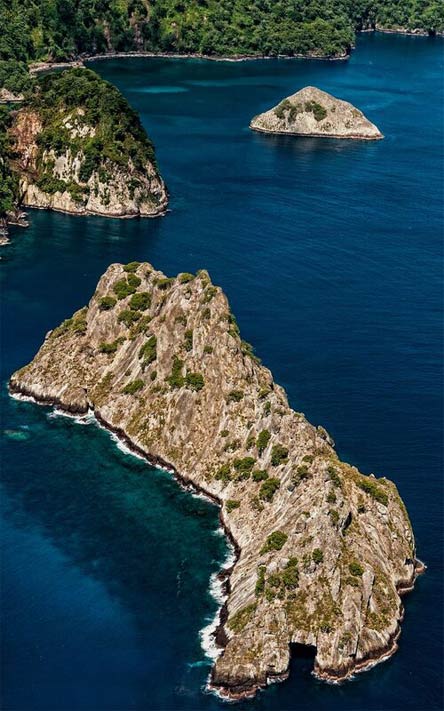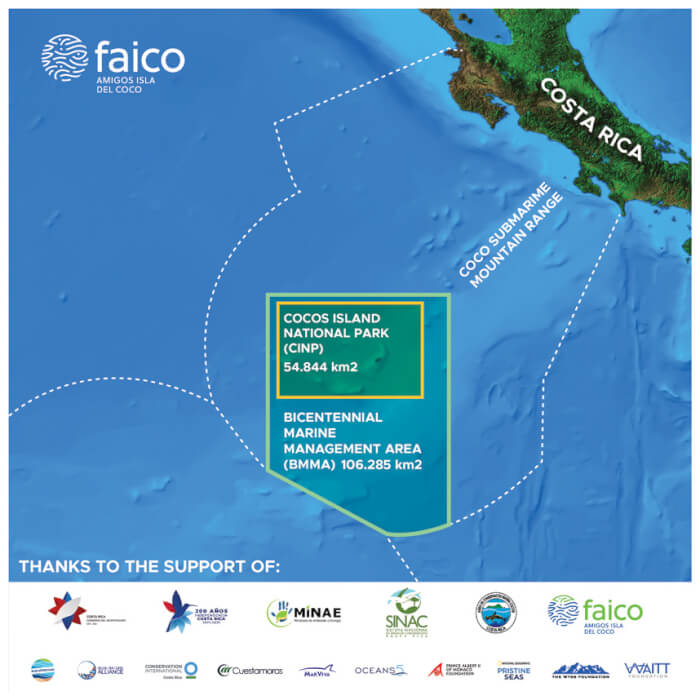Cocos Island

Coco Marine Conservation Area
The Coco Marine Conservation Area (ACMC) is one of the eleven Conservation Areas that make up the National System of Marine Conservation Areas of Costa Rica.
The ACMC includes both, the ecosystems associated with the protected wild areas Cocos Island National Park (PNIC) and the Bicentennial Marine Management Area (AMMB), as well as any other protected marine wildlife area that the country defines as of ecological or biological significance in the Pacific Ocean, seeking the proper health of ecosystems and stability of marine resources (according to article 4 of Executive Decree No. 40054-MINAE, amended in article 4 of Executive Decree No. 43368-MINAE).
Cocos Island and its surrounding waters, in the Exclusive Economic Zone (EEZ) of Costa Rica, stand out as key components for the sustainability of ecological and socioeconomic dynamics within the seascape of the Eastern Tropical Pacific (ETP).
Cocos Island, whose insular size reaches 24 km2, is located 532km southwest of the Pacific coast of Costa Rica. In order to preserve the natural state of the island, its islets and several seamounts of the Cocos Submarine Mountain Range, in 2021 the borderline of Cocos Island National Park (PNIC) was expanded, which now covers a marine space of 54,844 km2 (Executive Decree No. 43368-MINAE).
The expansion of the PNIC included now, under the category of National Park, the marine surface that was previously occupied by the Marine Area of Management of Seamounts (AMM-MS). This implied the creation of a new protected wildlife area, the Bicentennial Marine Management Area (AMMB), which covers a marine area of 106,285 km2 in total(Executive Decree No. 43368-MINAE). Between the PNIC and the AMMB, 30% of the country’s marine territory is included in some category of protected wildlife area, in compliance with global conservation goals.

Cocos Island National Park
The minimum conservation objectives that will guide the planning and management of Cocos Island National Park are the following (according to Executive Decree No. 43368-MINAE):
1. Preserve a significant part of the Cocos Submarine Mountain Range and its seamounts, which are recognized as sites of high biological diversity.
2. Conserve a representative sample of the essential habitat of elasmobranch species, which correspond to sites of concentration, mating, and migratory transit and cleaning stations.
3. Protect endemic, endangered and vulnerable species, such as the Cocos Island batfish (Ogilbia cocoensis), the hammerhead shark (Sphyrna lewini), the white-tip shark (Triaenodon obesus), the giant manta (Manta birostris), the Pacific green turtle (Chelonia mydas agassizi) as well as the ecosystems to which they are associated.
4. Establish a natural space where the mobility, connectivity and dispersion of species is promoted; as well as the adaptation for marine biodiversity to possible climatological and oceanographic modifications related to climate change.
5. Protect deep-sea ecosystems such as Mesophytic coral formations, azooxanthellate coral communities, abyssal plains, ridges (and their benthic communities, endemic species, and possible species new to science.
6. Preserve nesting, feeding and transit areas for seabirds.
7. Maintain the ecosystem services associated with the ecological processes that take place within the Cocos Island National Park.
8. Promote the structural and functional connectivity of highly migratory species at the level of the Eastern Tropical Pacific Marine Corridor.
Bicentennial Marine Management Area
The conservation objectives that will guide the planning and management of the Bicentennial Seamount Marine Area are the following: (according to Executive Decree No. 43368-MINAE):
1. Promote the conservation and sustainable use of one of the most productive marine areas in the Eastern Tropical Pacific.
2. Integrally manage a significant part of the marine ecosystem of the Cocos Submarine Mountain Range.
3. Conserve aggregation sites (resting, reproduction, cleaning, and feeding) of vulnerable, threatened, or endangered species, such as chelonians, cetaceans, elasmobranchs, and pelagic species, some of them of commercial importance.
4. Conserve deep-sea ecosystems such as mesophytic coral formations, azooxanthellate coral communities, abyssal plains, ridges, and their benthic communities, endemic species, and possible species new to science.
5. Preserve feeding and transit areas for seabirds.
6. Promote the structural and functional connectivity of highly migratory species at the level of the Eastern Tropical Pacific Corridor.

